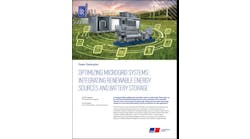Reeling from the third nor’easter in two weeks, New England offered up the perfect backdrop for Schneider Electric to unveil a new industrial microgrid project in Massachusetts this week.
The energy management and automation company plans to install the microgrid at its Foxboro manufacturing facility, located in a region where the latest storm caused 250,000 power outages. The plant was spared this time; it was not so lucky during a storm earlier in the month when power cuts forced it to halt production and send workers home. Such outages are costly, by some calculations averaging $15,709 per 30-minute blackout.
“If you have longer outages, it is much higher. For the U.S economy overall it is $150 billion a year,” said Mark Feasel, Schneider Electric’s vice president for utility segment, smart grid & microgrid.
When it’s complete next year, the industrial microgrid will provide an alternative source of power for the factory during outages. And while that benefit seemed uppermost during the blizzard, the project offers an even more interesting story on days when there is no threat to the grid
“This is a story about data,” said Feasel, during an interview at the 6th Global Microgrid Innovation Forum Wednesday, hosted by Smart Grid Observer in Washington, D.C. “When Schneider thinks about microgrids, we think about data, how data transforms how distributed energy resources work.”
It’s a story that Schneider hopes to roll out in a series of demonstration projects for targeted sectors, among them commercial buildings, factories, data centers and hospitals. The company began doing so last year with the unveiling of a microgrid at its Boston One Campus, its North American headquarters in Andover, Mass.
Boston One illustrated how a microgrid interfaces with building automation software. Now the Foxboro facility will show how a microgrid works within an industrial process.
“It’s important to note that all microgrids aren’t equal,” Feasel said.
In a commercial building, automation software focuses on keeping the building comfortable and safe. The priority is different in an industrial facility.
“If I were to put a microgrid in the building, that’s the primary process I would have to interface with. I could’t make you cold or hot. But in a factory, the building automation system isn’t the primary process. Energy consumption and demand is not driven by the temperature in the offices. The energy demand in a factory is determined by the output of the widgets; it is a production question.”
Feasel outlined how various controls answer that production question in the Foxboro facility.
One control system, the EcoStruxure Hybrid Distributed Control System One, co-optimizes production of factory widgets with energy demand and production. It manages assets, optimizes energy systems, and troubleshoots.
Another software package, EcoStruxure Microgrid Advisor, offers data on variables like grid prices, weather, and carbon reduction to aid in making energy choices.
A big data application, EcoStruxure Profit Advisor performs real-time simulations to illustrate the results of various modes of operation, and how they might affect the manufacturer’s output and costs, such as those for raw material and energy. Sitting at the cloud level, it offers insight into how every production asset within the plant contributes to the operational profitability of the company.
A fourth software package, Termis District Energy Optimization Software, provides insight into tools that operate power plants. In this case, the software optimizes a 250-kW combined heat and power plant, a signature technology for Schneider microgrids.
Schneider has taken a dual role in creating the demonstration sites. On the one hand, it acts as the customer; on the other it is part of the team developing the microgrid. The company makes a point of separating the roles, so that the customer team treats the microgrid development team as it would any other vendor, requiring the same cost and performance standards.
Mark Feasel will discuss microgrid financing at Microgrid 2018, May 7-9 in Chicago.
The Foxboro plant, known as Schneider Electric’s Process Automation North American Power Generation Center of Excellence, will operate under a microgrid-as-a-service model (MaaS). Duke Energy’s REC Solar will act as the capital partner. The competitive arm of Duke will procure the software controls, maintenance and optimization services and warranties from Schneider.
MaaS allows a customer to install a microgrid without upfront capital costs. Duke will charge Schneider a cost/kWh for the output of the microgrid under a power purchase agreement. The solar is priced at a predictable rate pegged to the local utility green rate. Cost savings from the solar helps pay for the cost of the software that creates energy resilience for the factory.
Together, the solar and the CHP create slight savings for Schneider at a fixed energy cost. As Feasel sees it, the project frees the manufacturer from worrying about price escalation with the added benefit of providing energy reliability.
The industrial microgrid will be rolled out in three phases. The first will incorporate solar, the second CHP, and the third, with funding anticipated from the state, energy storage.
This will be the third MaaS project for the Schneider Electric, REC Solar and Duke Energy Renewables team. The project also contributes to Schneider’s plan to become carbon neutral by 2030.
Track news about industrial microgrid projects by subscribing to the free Microgrid Knowledge newsletter.






